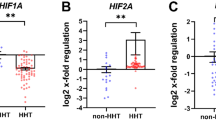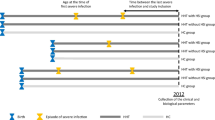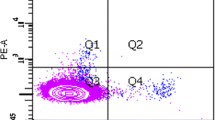Abstract
Hereditary Hemorrhagic Telangiectasia (HHT) is an autosomal dominant disorder characterized by vascular malformations. The genes known to be associated with HHT include ENG (HHT1), ACVRL1 (HHT2) and SMAD4 (JPHT). It has been reported that circulating CD34+ cell subsets repair damaged vessels. To investigate whether mobilization of these cells is present in the peripheral blood (PB) of HTT patients, we analyzed CD34+ cells, CD34+VEGFR-2+ progenitor or mature endothelial cells, and CD34+CD133+VEGFR-2− hematopoietic progenitor cells (HPCs). Cytofluorimetric analysis was performed in 150 HTT patients and 43 healthy subjects (CTRLs). In HTT patients, PB CD34+ cells were significantly increased; the frequency of endothelial cells was higher (P = 0.002), while the frequency of CD34+CD133+VEGFR-2− HPCs was lower (P = 0.00007) than in CTRLs. Results were comparable in patients with ENG or ACVRL1 gene mutation; in patients with ENG mutation, the frequency of the cell subsets inversely correlated with the age of the patients at time of sampling (CD34+), disease duration (CD34+VEGFR-2+), and age at disease onset (CD34+CD133+ VEGFR-2−). In conclusion, HHT patients show an increase of circulating endothelial cells and a decrease of HPCs. In patients with ENG mutation, the frequency of CD34+ endothelial cells correlates with specific clinical characteristics suggesting that their active turnover characterizes the initial phase of the disease.

Similar content being viewed by others
Abbreviations
- HHT:
-
Hereditary Hemorrhagic Telangiectasia
- AVMs:
-
Arteriovenous malformations
- TGFβ:
-
Transforming growth factor β
- BMPs:
-
Bone morphogenetic proteins
- ECs:
-
Endothelial cells
- HPCs:
-
Hematopoietic progenitor cells
- EPCs:
-
Endothelial progenitor cells
- PB:
-
Peripheral blood
- CTRLs:
-
Healthy subjects
References
Faughnan M, Palda V, Garcia-Tsao G, Geisthoff U, McDonald J, Proctor D, Spears J, Brown D, Buscarini E, Chesnutt M, Cottin V, Ganguly A, Gossage J, Guttmacher A, Hyland R, Kennedy S, Korzenik J, Mager J, Ozanne A, Piccirillo J, Picus D, Plauchu H, Porteous M, Pyeritz R, Ross D, Sabba C, Swanson K, Terry P, Wallace M, Westermann C, White R, Young L, Zarrabeitia R. International guidelines for the diagnosis and management of hereditary hemorrhagic telangiectasia. J Med Genet. 2011;48:73–87.
Shovlin CL. Hereditary haemorrhagic telangiectasia: pathophysiology, diagnosis and treatment. Blood Rev. 2010;24:203–19.
Govani FS, Shovlin CL. Hereditary haemorrhagic telangiectasia: a clinical and scientific review. Eur J Hum Genet. 2009;17:860–71.
Lesca G, Genin E, Blachier C, Olivieri C, Coulet F, Brunet G, Dupuis-Girod S, Buscarini E, Soubrier F, Calender A, Danesino C, Giraud S, Plauchu H, Network F-IH. Hereditary hemorrhagic telangiectasia: evidence for regional founder effects of ACVRL1 mutations in French and Italian patients. Eur J Hum Genet. 2008;16:742–9.
Lesca G, Olivieri C, Burnichon N, Pagella F, Carette MF, Gilbert-Dussardier B, Goizet C, Roume J, Rabilloud M, Saurin JC, Cottin V, Honnorat J, Coulet F, Giraud S, Calender A, Danesino C, Buscarini E, Plauchu H, Network F–I–R–O. Genotype–phenotype correlations in hereditary hemorrhagic telangiectasia: data from the French–Italian HHT network. Genet Med. 2007;9:14–22.
Gallione C, Scheessele E, Reinhardt D, Duits A, Berg J, Westermann C, Marchuk D. Two common endoglin mutations in families with hereditary hemorrhagic telangiectasia in The Netherlands antilles: evidence for a founder effect. Hum Genet. 2000;107:40–4.
Shovlin CL, Guttmacher AE, Buscarini E, Faughnan ME, Hyland RH, Westermann CJ, Kjeldsen AD, Plauchu H. Diagnostic criteria for hereditary hemorrhagic telangiectasia (Rendu–Osler–Weber syndrome). Am J Med Genet. 2000;91:66–7.
McAllister KA, Grogg KM, Johnson DW, Gallione CJ, Baldwin MA, Jackson CE, Helmbold EA, Markel DS, McKinnon WC, Murrell J, et al. Endoglin, a TGF-beta binding protein of endothelial cells, is the gene for hereditary haemorrhagic telangiectasia type 1. Nat Genet. 1994;8:345–51.
Johnson DW, Berg JN, Baldwin MA, Gallione CJ, Marondel I, Yoon SJ, Stenzel TT, Speer M, Pericak-Vance MA, Diamond A, Guttmacher AE, Jackson CE, Attisano L, Kucherlapati R, Porteous ME, Marchuk DA. Mutations in the activin receptor-like kinase 1 gene in hereditary haemorrhagic telangiectasia type 2. Nat Genet. 1996;13:189–95.
Trembath R, Thomson J, Machado R, Morgan N, Atkinson C, Winship I, Simonneau G, Galie N, Loyd J, Humbert M, Nichols W, Morrell N, Berg J, Manes A, McGaughran J, Pauciulo M, Wheeler L. Clinical and molecular genetic features of pulmonary hypertension in patients with hereditary hemorrhagic telangiectasia. N Engl J Med. 2001;345:325–34.
Olivieri C, Lanzarini L, Pagella F, Semino L, Corno S, Valacca C, Plauchu H, Lesca G, Barthelet M, Buscarini E, Danesino C. Echocardiographic screening discloses increased values of pulmonary artery systolic pressure in 9 of 68 unselected patients affected with hereditary hemorrhagic telangiectasia. Genet Med. 2006;8:183–90.
Gallione CJ, Repetto GM, Legius E, Rustgi AK, Schelley SL, Tejpar S, Mitchell G, Drouin E, Westermann CJ, Marchuk DA. A combined syndrome of juvenile polyposis and hereditary haemorrhagic telangiectasia associated with mutations in MADH4 (SMAD4). Lancet. 2004;363:852–9.
Cole SG, Begbie ME, Wallace GM, Shovlin CL. A new locus for hereditary haemorrhagic telangiectasia (HHT3) maps to chromosome 5. J Med Genet. 2005;42:577–82.
Bayrak-Toydemir P, McDonald J, Akarsu N, Toydemir RM, Calderon F, Tuncali T, Tang W, Miller F, Mao R. A fourth locus for hereditary hemorrhagic telangiectasia maps to chromosome 7. Am J Med Genet A. 2006;140:2155–62.
David L, Mallet C, Mazerbourg S, Feige JJ, Bailly S. Identification of BMP9 and BMP10 as functional activators of the orphan activin receptor-like kinase 1 (ALK1) in endothelial cells. Blood. 2007;109:1953–61.
Fu Y, Chang A, Chang L, Niessen K, Eapen S, Setiadi A, Karsan A. Differential regulation of transforming growth factor beta signaling pathways by notch in human endothelial cells. J Biol Chem. 2009;284:19452–62.
Lebrin F, Srun S, Raymond K, Martin S, van den Brink S, Freitas C, Bréant C, Mathivet T, Larrivée B, Thomas JL, Arthur HM, Westermann CJ, Disch F, Mager JJ, Snijder RJ, Eichmann A, Mummery CL. Thalidomide stimulates vessel maturation and reduces epistaxis in individuals with hereditary hemorrhagic telangiectasia. Nat Med. 2010;16:420–8.
Fernandez-L A, Sanz-Rodriguez F, Zarrabeitia R, Pérez-Molino A, Hebbel R, Nguyen J, Bernabéu C, Botella L. Blood outgrowth endothelial cells from hereditary haemorrhagic telangiectasia patients reveal abnormalities compatible with vascular lesions. Cardiovasc Res. 2005;68:235–48.
Zucco L, Zhang Q, Kuliszewski MA, Kandic I, Faughnan ME, Stewart DJ, Kutryk MJ. Circulating angiogenic cell dysfunction in patients with hereditary hemorrhagic telangiectasia. PLoS One. 2014;9:e89927.
Yoder MC, Mead LE, Prater D, Krier TR, Mroueh KN, Li F, Krasich R, Temm CJ, Prchal JT, Ingram DA. Redefining endothelial progenitor cells via clonal analysis and hematopoietic stem/progenitor cell principals. Blood. 2007;109:1801–9.
Yoder MC. Human endothelial progenitor cells. Cold Spring Harb Perspect Med. 2012;2:a006692.
Case J, Mead LE, Bessler WK, Prater D, White HA, Saadatzadeh MR, Bhavsar JR, Yoder MC, Haneline LS, Ingram DA. Human CD34+AC133+VEGFR-2+ cells are not endothelial progenitor cells but distinct, primitive hematopoietic progenitors. Exp Hematol. 2007;35:1109–18.
Werner N, Kosiol S, Schiegl T, Ahlers P, Walenta K, Link A, Böhm M, Nickenig G. Circulating endothelial progenitor cells and cardiovascular outcomes. N Engl J Med. 2005;353:999–1007.
Peichev M, Naiyer AJ, Pereira D, Zhu Z, Lane WJ, Williams M, Oz MC, Hicklin DJ, Witte L, Moore MA, Rafii S. Expression of VEGFR-2 and AC133 by circulating human CD34(+) cells identifies a population of functional endothelial precursors. Blood. 2000;95:952–8.
Faughnan ME, Palda VA, Garcia-Tsao G, Geisthoff UW, McDonald J, Proctor DD, Spears J, Brown DH, Buscarini E, Chesnutt MS, Cottin V, Ganguly A, Gossage JR, Guttmacher AE, Hyland RH, Kennedy SJ, Korzenik J, Mager JJ, Ozanne AP, Piccirillo JF, Picus D, Plauchu H, Porteous ME, Pyeritz RE, Ross DA, Sabba C, Swanson K, Terry P, Wallace MC, Westermann CJ, White RI, Young LH, Zarrabeitia R, Group HHTFI-GW. International guidelines for the diagnosis and management of hereditary haemorrhagic telangiectasia. J Med Genet. 2011;48:73–87.
Olivieri C, Pagella F, Semino L, Lanzarini L, Valacca C, Pilotto A, Corno S, Scappaticci S, Manfredi G, Buscarini E, Danesino C. Analysis of eng and ACVRL1 genes in 137 HHT italian families identifies 76 different mutations (24 novel). Comparison with other European studies. J Hum Genet. 2007;52:820–9.
Prater DN, Case J, Ingram DA, Yoder MC. Working hypothesis to redefine endothelial progenitor cells. Leukemia. 2007;21:1141–9.
Borges L, Iacovino M, Mayerhofer T, Koyano-Nakagawa N, Baik J, Garry DJ, Kyba M, Letarte M, Perlingeiro RC. A critical role for endoglin in the emergence of blood during embryonic development. Blood. 2012;119:5417–28.
Chen CZ, Li M, de Graaf D, Monti S, Göttgens B, Sanchez MJ, Lander ES, Golub TR, Green AR, Lodish HF. Identification of endoglin as a functional marker that defines long-term repopulating hematopoietic stem cells. Proc Natl Acad Sci USA. 2002;99:15468–73.
Buckley CD, Amft N, Bradfield PF, Pilling D, Ross E, Arenzana-Seisdedos F, Amara A, Curnow SJ, Lord JM, Scheel-Toellner D, Salmon M. Persistent induction of the chemokine receptor CXCR4 by TGF-beta 1 on synovial t cells contributes to their accumulation within the rheumatoid synovium. J Immunol. 2000;165:3423–9.
Scheubel RJ, Zorn H, Silber RE, Kuss O, Morawietz H, Holtz J, Simm A. Age-dependent depression in circulating endothelial progenitor cells in patients undergoing coronary artery bypass grafting. J Am Coll Cardiol. 2003;42:2073–80.
Acknowledgments
We wish to thank the Patients who collaborate to this research.
Conflict of interest
The authors declare not to have any conflict of interest.
Financial support
CC CD and CO are funded by the charity Italian HHT Patients’. Foundation: Associazione FONDAZIONE ITALIANA HHT “Onilde Carini”.
Author information
Authors and Affiliations
Corresponding author
Additional information
C. Canzonieri and R. Campanelli equally contributed to experimental work.
V. Rosti and C. Olivieri equally contributed to writing the paper.
About this article
Cite this article
Massa, M., Canzonieri, C., Campanelli, R. et al. Increase of circulating endothelial cells in patients with Hereditary Hemorrhagic Telangiectasia. Int J Hematol 101, 23–31 (2015). https://doi.org/10.1007/s12185-014-1698-4
Received:
Revised:
Accepted:
Published:
Issue Date:
DOI: https://doi.org/10.1007/s12185-014-1698-4




